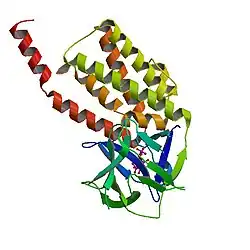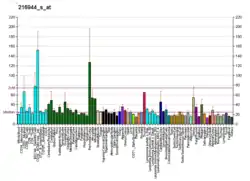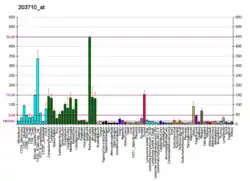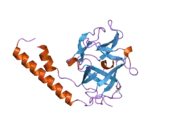ITPR1
Inositol 1,4,5-trisphosphate receptor type 1 is a protein that in humans is encoded by the ITPR1 gene.[5][6][7][8][9]
References
- GRCh38: Ensembl release 89: ENSG00000150995 - Ensembl, May 2017
- GRCm38: Ensembl release 89: ENSMUSG00000030102 - Ensembl, May 2017
- "Human PubMed Reference:". National Center for Biotechnology Information, U.S. National Library of Medicine.
- "Mouse PubMed Reference:". National Center for Biotechnology Information, U.S. National Library of Medicine.
- Yamada N, Makino Y, Clark RA, Pearson DW, Mattei MG, Guénet JL, Ohama E, Fujino I, Miyawaki A, Furuichi T (Sep 1994). "Human inositol 1,4,5-trisphosphate type-1 receptor, InsP3R1: structure, function, regulation of expression and chromosomal localization". The Biochemical Journal. 302 (Pt 3): 781–90. doi:10.1042/bj3020781. PMC 1137299. PMID 7945203.
- Nucifora FC, Li SH, Danoff S, Ullrich A, Ross CA (Sep 1995). "Molecular cloning of a cDNA for the human inositol 1,4,5-trisphosphate receptor type 1, and the identification of a third alternatively spliced variant". Brain Research. Molecular Brain Research. 32 (2): 291–6. doi:10.1016/0169-328X(95)00089-B. PMID 7500840.
- van de Leemput J, Chandran J, Knight MA, Holtzclaw LA, Scholz S, Cookson MR, Houlden H, Gwinn-Hardy K, Fung HC, Lin X, Hernandez D, Simon-Sanchez J, Wood NW, Giunti P, Rafferty I, Hardy J, Storey E, Gardner RJ, Forrest SM, Fisher EM, Russell JT, Cai H, Singleton AB (Jun 2007). "Deletion at ITPR1 underlies ataxia in mice and spinocerebellar ataxia 15 in humans". PLOS Genetics. 3 (6): e108. doi:10.1371/journal.pgen.0030108. PMC 1892049. PMID 17590087.
- Iwaki A, Kawano Y, Miura S, Shibata H, Matsuse D, Li W, Furuya H, Ohyagi Y, Taniwaki T, Kira J, Fukumaki Y (Jan 2008). "Heterozygous deletion of ITPR1, but not SUMF1, in spinocerebellar ataxia type 16". Journal of Medical Genetics. 45 (1): 32–5. doi:10.1136/jmg.2007.053942. PMID 17932120. S2CID 7730102.
- "Entrez Gene: ITPR1 inositol 1,4,5-triphosphate receptor, type 1".
- Ando H, Mizutani A, Matsu-ura T, Mikoshiba K (Mar 2003). "IRBIT, a novel inositol 1,4,5-trisphosphate (IP3) receptor-binding protein, is released from the IP3 receptor upon IP3 binding to the receptor". The Journal of Biological Chemistry. 278 (12): 10602–12. doi:10.1074/jbc.M210119200. PMID 12525476.
- Hirota J, Ando H, Hamada K, Mikoshiba K (Jun 2003). "Carbonic anhydrase-related protein is a novel binding protein for inositol 1,4,5-trisphosphate receptor type 1". The Biochemical Journal. 372 (Pt 2): 435–41. doi:10.1042/BJ20030110. PMC 1223404. PMID 12611586.
- Maximov A, Tang TS, Bezprozvanny I (Feb 2003). "Association of the type 1 inositol (1,4,5)-trisphosphate receptor with 4.1N protein in neurons". Molecular and Cellular Neurosciences. 22 (2): 271–83. doi:10.1016/s1044-7431(02)00027-1. PMID 12676536. S2CID 2317354.
- MacMillan D, Currie S, Bradley KN, Muir TC, McCarron JG (Dec 2005). "In smooth muscle, FK506-binding protein modulates IP3 receptor-evoked Ca2+ release by mTOR and calcineurin". Journal of Cell Science. 118 (Pt 23): 5443–51. doi:10.1242/jcs.02657. PMID 16278292.
- Cameron AM, Nucifora FC, Fung ET, Livingston DJ, Aldape RA, Ross CA, Snyder SH (Oct 1997). "FKBP12 binds the inositol 1,4,5-trisphosphate receptor at leucine-proline (1400-1401) and anchors calcineurin to this FK506-like domain". The Journal of Biological Chemistry. 272 (44): 27582–8. doi:10.1074/jbc.272.44.27582. PMID 9346894.
- Schlossmann J, Ammendola A, Ashman K, Zong X, Huber A, Neubauer G, Wang GX, Allescher HD, Korth M, Wilm M, Hofmann F, Ruth P (Mar 2000). "Regulation of intracellular calcium by a signalling complex of IRAG, IP3 receptor and cGMP kinase Ibeta". Nature. 404 (6774): 197–201. Bibcode:2000Natur.404..197S. doi:10.1038/35004606. PMID 10724174. S2CID 205004996.
- Mehta D, Ahmmed GU, Paria BC, Holinstat M, Voyno-Yasenetskaya T, Tiruppathi C, Minshall RD, Malik AB (Aug 2003). "RhoA interaction with inositol 1,4,5-trisphosphate receptor and transient receptor potential channel-1 regulates Ca2+ entry. Role in signaling increased endothelial permeability". The Journal of Biological Chemistry. 278 (35): 33492–500. doi:10.1074/jbc.M302401200. PMID 12766172.
- Yuan JP, Kiselyov K, Shin DM, Chen J, Shcheynikov N, Kang SH, Dehoff MH, Schwarz MK, Seeburg PH, Muallem S, Worley PF (Sep 2003). "Homer binds TRPC family channels and is required for gating of TRPC1 by IP3 receptors". Cell. 114 (6): 777–89. doi:10.1016/s0092-8674(03)00716-5. PMID 14505576. S2CID 10552676.
- Mery L, Magnino F, Schmidt K, Krause KH, Dufour JF (Jan 2001). "Alternative splice variants of hTrp4 differentially interact with the C-terminal portion of the inositol 1,4,5-trisphosphate receptors". FEBS Letters. 487 (3): 377–83. doi:10.1016/s0014-5793(00)02362-0. PMID 11163362. S2CID 44945442.
- Argent L, Winter F, Prickett L, Carrasquero-Ordaz M, Olsen AL, Kramer H, Lancaster E, Becker EB (Sep 2020). "Caspr2 interacts with type 1 inositol 1,4,5-trisphosphate receptor in the developing cerebellum and regulatesPurkinje cell morphology". The Journal of Biological Chemistry. 295 (36): 12716–26. doi:10.1074/jbc.RA120.012655. PMC 7476715. PMID 32675284.
Further reading
- Stove V, Verhasselt B (Jan 2006). "Modelling thymic HIV-1 Nef effects". Current HIV Research. 4 (1): 57–64. doi:10.2174/157016206775197583. PMID 16454711.
- Joseph SK, Lin C, Pierson S, Thomas AP, Maranto AR (Oct 1995). "Heteroligomers of type-I and type-III inositol trisphosphate receptors in WB rat liver epithelial cells". The Journal of Biological Chemistry. 270 (40): 23310–6. doi:10.1074/jbc.270.40.23310. PMID 7559486.
- Harnick DJ, Jayaraman T, Ma Y, Mulieri P, Go LO, Marks AR (Feb 1995). "The human type 1 inositol 1,4,5-trisphosphate receptor from T lymphocytes. Structure, localization, and tyrosine phosphorylation". The Journal of Biological Chemistry. 270 (6): 2833–40. doi:10.1074/jbc.270.6.2833. PMID 7852357.
- Wojcikiewicz RJ, Furuichi T, Nakade S, Mikoshiba K, Nahorski SR (Mar 1994). "Muscarinic receptor activation down-regulates the type I inositol 1,4,5-trisphosphate receptor by accelerating its degradation". The Journal of Biological Chemistry. 269 (11): 7963–9. doi:10.1016/S0021-9258(17)37145-4. PMID 8132516.
- Komalavilas P, Lincoln TM (Mar 1994). "Phosphorylation of the inositol 1,4,5-trisphosphate receptor by cyclic GMP-dependent protein kinase". The Journal of Biological Chemistry. 269 (12): 8701–7. doi:10.1016/S0021-9258(17)37024-2. PMID 8132598.
- Cameron AM, Steiner JP, Roskams AJ, Ali SM, Ronnett GV, Snyder SH (Nov 1995). "Calcineurin associated with the inositol 1,4,5-trisphosphate receptor-FKBP12 complex modulates Ca2+ flux". Cell. 83 (3): 463–72. doi:10.1016/0092-8674(95)90124-8. PMID 8521476. S2CID 11594556.
- Yan J, Khanna KK, Lavin MF (May 1996). "Induction of inositol 1,4,5 trisphosphate receptor genes by ionizing radiation". International Journal of Radiation Biology. 69 (5): 539–46. doi:10.1080/095530096145544. PMID 8648241.
- Quinton TM, Dean WL (Jul 1996). "Multiple inositol 1,4,5-trisphosphate receptor isoforms are present in platelets". Biochemical and Biophysical Research Communications. 224 (3): 740–6. doi:10.1006/bbrc.1996.1093. PMID 8713116.
- Cameron AM, Nucifora FC, Fung ET, Livingston DJ, Aldape RA, Ross CA, Snyder SH (Oct 1997). "FKBP12 binds the inositol 1,4,5-trisphosphate receptor at leucine-proline (1400-1401) and anchors calcineurin to this FK506-like domain". The Journal of Biological Chemistry. 272 (44): 27582–8. doi:10.1074/jbc.272.44.27582. PMID 9346894.
- Deelman LE, Jonk LJ, Henning RH (Jan 1998). "The isolation and characterization of the promoter of the human type 1 inositol 1,4,5-trisphosphate receptor". Gene. 207 (2): 219–25. doi:10.1016/S0378-1119(97)00630-6. PMID 9511764.
- Martin C, Chapman KE, Seckl JR, Ashley RH (Jul 1998). "Partial cloning and differential expression of ryanodine receptor/calcium-release channel genes in human tissues including the hippocampus and cerebellum". Neuroscience. 85 (1): 205–16. doi:10.1016/S0306-4522(97)00612-X. PMID 9607712. S2CID 25634042.
- Tu JC, Xiao B, Yuan JP, Lanahan AA, Leoffert K, Li M, Linden DJ, Worley PF (Oct 1998). "Homer binds a novel proline-rich motif and links group 1 metabotropic glutamate receptors with IP3 receptors". Neuron. 21 (4): 717–26. doi:10.1016/S0896-6273(00)80589-9. PMID 9808459. S2CID 2851554.
- Kiselyov K, Xu X, Mozhayeva G, Kuo T, Pessah I, Mignery G, Zhu X, Birnbaumer L, Muallem S (Dec 1998). "Functional interaction between InsP3 receptors and store-operated Htrp3 channels". Nature. 396 (6710): 478–82. Bibcode:1998Natur.396..478K. doi:10.1038/24890. PMID 9853757. S2CID 4423316.
- Lin P, Yao Y, Hofmeister R, Tsien RY, Farquhar MG (Apr 1999). "Overexpression of CALNUC (nucleobindin) increases agonist and thapsigargin releasable Ca2+ storage in the Golgi". The Journal of Cell Biology. 145 (2): 279–89. doi:10.1083/jcb.145.2.279. PMC 2133108. PMID 10209024.
- Schlossmann J, Ammendola A, Ashman K, Zong X, Huber A, Neubauer G, Wang GX, Allescher HD, Korth M, Wilm M, Hofmann F, Ruth P (Mar 2000). "Regulation of intracellular calcium by a signalling complex of IRAG, IP3 receptor and cGMP kinase Ibeta". Nature. 404 (6774): 197–201. Bibcode:2000Natur.404..197S. doi:10.1038/35004606. PMID 10724174. S2CID 205004996.
- Dias Neto E, Correa RG, Verjovski-Almeida S, Briones MR, Nagai MA, da Silva W, Zago MA, Bordin S, Costa FF, Goldman GH, Carvalho AF, Matsukuma A, Baia GS, Simpson DH, Brunstein A, de Oliveira PS, Bucher P, Jongeneel CV, O'Hare MJ, Soares F, Brentani RR, Reis LF, de Souza SJ, Simpson AJ (Mar 2000). "Shotgun sequencing of the human transcriptome with ORF expressed sequence tags". Proceedings of the National Academy of Sciences of the United States of America. 97 (7): 3491–6. Bibcode:2000PNAS...97.3491D. doi:10.1073/pnas.97.7.3491. PMC 16267. PMID 10737800.
- Mayne M, Holden CP, Nath A, Geiger JD (Jun 2000). "Release of calcium from inositol 1,4,5-trisphosphate receptor-regulated stores by HIV-1 Tat regulates TNF-alpha production in human macrophages". Journal of Immunology. 164 (12): 6538–42. doi:10.4049/jimmunol.164.12.6538. PMID 10843712.
- Tanimura A, Tojyo Y, Turner RJ (Sep 2000). "Evidence that type I, II, and III inositol 1,4,5-trisphosphate receptors can occur as integral plasma membrane proteins". The Journal of Biological Chemistry. 275 (35): 27488–93. doi:10.1074/jbc.M004495200. PMID 10874040.
External links
- ITPR1+protein,+human at the U.S. National Library of Medicine Medical Subject Headings (MeSH)
- GeneReviews/NCBI/NIH/UW entry on Spinocerebellar Ataxia Type 15
This article is issued from Wikipedia. The text is licensed under Creative Commons - Attribution - Sharealike. Additional terms may apply for the media files.









